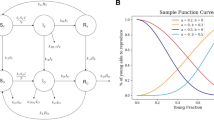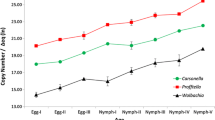Abstract
Delphacodes kuscheli establish mutualistic relationship with yeast-like symbionts (YLS) that live in the fat body and are necessary for host survival and reproduction. We estimated for a host of age t, its body weight, W(t), and the number of YLS per host, YLS(t). The host body weight was calculated as: W(t) = Lm/[1+ e (d–kt)], (Lm = the maximum observed weight, and d and k are constants), and the fat body was considered a fixed proportion of W(t). We calculated the number of YLS per unit host body mass: α(t) = YLS(t)/W(t). We also calculated the number of YLS per host, cYLS(t), and analyzed the pattern of variation in both sexes adapting the expression of the logistic model: cYLS(t) = KNoert/K+(ert -1)No, (No = initial number of YLS, r = intrinsic per capita rate of natural increase, and K = variable carrying capacity). In females the carrying capacity varied according to a constant proportion of the host’s weight: K(t) = αW(t). In males α(t) was considered a decreasing function of the host age: K(t) = α(t)W(t). The coefficients No, α, and r were subjected to parameterization. We found that the patterns of W(t) and YLS(t) of D. kuscheli were similar to other planthoppers. In females YLS increased up to the adult stage and then remained almost constant, varying similarly to individual weight. In males YLS increased up to the 5th instar nymph as the individual weight did, but the number of YLS decreased in the adult stage and the correlation was not so good. The calculated number of YLS per host matches reasonably well with the number estimated experimentally both in females and males. This is the first study that quantified and modeled the dynamics of YLS endosymbionts in a Neotropical planthopper pest. The models will be used in future studies for better understand the experimental reduction of YLS in young nymphal stages.




Similar content being viewed by others
References
Arrese EL, Soulages JL (2010) Insect fat body: energy, metabolism, and regulation. Annu Rev Entomol 55:207–225
Baumman P (2005) Biology of bacteryocites-associated endosymbionts of plant sap-sucking insects. Annu Rev Microbiol 59:155–189
Boito GT, Ornaghi JA (2008) Rol de los cereales de invierno y su sistema de manejo en la dinámica poblacional de Delphacodes kuscheli, insecto vector del MRCV. Agriscientia 25:17–26
Brentassi ME (2004) Estudio de la interacción planta-insecto. Comportamiento alimentario del vector del Mal de Río Cuarto del maíz, Delphacodes kuscheli Fennah (Insecta: Hemiptera: Delphacidae). Doctoral thesis. La Plata, Argentina: Universidad Nacional de La Plata.
Brentassi ME, Remes Lenicov A (2007) Feeding behavior of the vector Delphacodes kuscheli (Hemiptera: Fulgoromorpha: Delphacidae) on maize and oat. Ann Soc Entomol Fr 43:205–212
Brentassi ME, Liljhestrom G, Remes Lenicov A (2010) Endosimbiontes obligados (yeast like symbiotes) de Delphacodes kuscheli (Hemiptera: Delphacidae), vector del Mal de Río Cuarto del maíz en Argentina. Cuantificación y caracterización morfológica. Rev Argent Microbiol 42(s1):222
Brentassi ME, de la Fuente D, Lameiro A (2014) Localización y caracterización morfológica de endosimbiontes obligados de Delphacodes kuscheli y Dalbulus maidis, dos especies de chicharritas vectoras de enfermedades del cultivo de maíz en Argentina (Hemiptera: Auchenorryncha). Rev Cien Morfol Soc Cien Morfol La Plata 16(s1):1–7
Buchner P (1965) Endosymbiosis of animals with plant microorganisms interscience. Publishers, New York
Bush AO, Holmes JC (1986) Intestinal parasites of lesser scaup ducks: patterns and associations. Can J Zool 64:132–141
Chen Y (2009) Variation in planthopper rice variation in planthopper-rice interactions: possible interactions among three species? In: Heong KL, Hardy B (eds) Planthoppers: new threats to the sustainability of intensive rice production system in Asia. International Rice Research Institute, Los Baños, Philippines, pp 315–326
Chen CC, Cheng LL, Kuan CC, Hou RF (1981a) Studies on the intracellular yeast like symbiote in the brown planthopper, Nilparvata lugens (Stål) I Histological observations and population changes of the symbiote. Z Angew Entomol 91:321–327
Chen CC, Cheng LL, Hou RF (1981b) Studies on the intracellular yeast like symbiote in the brown planthopper. Nilaparvata lugens (Stål) II. Effects of antibiotics and elevated temperature on the symbiotes and their host. J Appl Entomol 92:440–449
Cheng DJ, Hou RF (2001) Histological observations on transovarial transmission of a yeast-like symbiote in Nilaparvata lugens Stål (Homoptera: Delphacidae). Tissue Cell 33:273–279
Costamagna A, Remes Lenicov A, Zanelli M (2005) Maize and oat antixenosis and antibiosis against Delphacodes kuscheli (Homoptera: Delphacidae), vector of “Mal de Río Cuarto” of maize in Argentina. J Econ Entomol 98:1374–1381
Day NE (1966) Fitting curves to longitudinal data. Biometrics 22:276–291
Dean RL, Collins JV, Locke M (1985) Structure of the fat body. In: Kerkut GA, Gilbert LI (eds) Comprehensive insect physiology, biochemistry and pharmacology. Pergamon, New York, pp 155–210
Denno RF, Roderick GK (1990) Population biology of planthoppers. Annu Rev Entomol 35:489–520
Douglas E (1998) Nutritional interactions in insect–microbial symbioses: aphids and their symbiotic bacteria Buchnera. Annu Rev Entomol 43:17–37
Ferrater JB, De Jong PW, Dicke M, Chen YH, Horgan FG (2013) Symbiont-mediated adaptation by planthoppers and leafhoppers to resistant rice varieties. Arthropod Plant Interact 7:591–605
Ferrater JB, Naredo AI, Almazan MLP, De Jong PW, Dicke M, Horgan FG (2015) Varied responses by yeast-like symbionts during virulence adaptation in a monophagous phloem-feeding insect. Arthropod Plant Interact 9:215–224
Fukatsu T, Ishikawa H (1992) Soldier and male of an eusocial aphid Colophina arma lack endosymbiont: implications for physiological and evolutionary interaction between host and symbiont. J Insect Physiol 38:1033–1042
Haefner JW (1996) Modeling biological systems. Principles and applications, New York, USA
Hongoh Y, Ishikawa H (1997) Uric acid as a nitrogen resource for the brown planthopper, Nilaparvata lugens: Studies with synthetic diets and aposymbiotic insects. Zool Sci 14:581–586
Kaltenpoth M, Goettler W, Koehler S, Strohm E (2010) Life cycle and population dynamics of a protective insect symbiont reveal severe bottlenecks during vertical transmission. Evol Ecol 24:463–477
Koga R, Tsuchida T, Fukatsu T (2003) Changing partners in an obligate symbiosis: a facultative endosymbiont can compensate for loss of the essential endosymbiont Buchnera in an aphid. Proc R Soc Lond B 270:2543–2550
Kono M, Koga R, Shimada M, Fukatsu T (2008) Infection dynamics of coexisting Beta- and Gammaproteobacteria in the nested endosymbiotic system of mealybugs. Appl Environ Microbiol 74:4175–4184
Lampel G (1959) Geschlecht und Symbiose bei den Pemphiginen. Z Morphol Okol Tiere 48:320–348
Lease HM, Wolf BO (2011) Lipid content of terrestrial arthropods in relation to body size, phylogeny, ontogeny and sex. Physiol Entomol 36:29–38
Lee YH, Hou FR (1987) Physiological roles of yeast like symbiote in reproduction and embryonic development of the brown planthopper, Nilparvata lugens Stål. J Insect Physiol 33:851–860
Lenardón SL, March GJ, Nome SF, Ornaghi JA (1998) Recient outbreak of “Mal de Río Cuarto” virus on corn in Argentina. Plant Dis 82:448
Lu ZX, Yu XP, Chen JM, Zheng XS, Xu HX, Zhang JF, Chen LZ (2004) Dynamics of yeast-like symbiote and its relationship with the virulence of brown planthopper, Nilaparvata lugens Stål, to resistant rice varieties. J Asia Pac Entomol 7:317–323
Michalik A, Jankowska W, Szklarzewicz T (2009) Ultrastructure and transovarial transmission of endosymbiotic microorganisms in Conomelus anceps and Metcalfa pruinosa (Insecta: Hemiptera: Fulgoromorpha). Folia Biol (Kraków) 57:131–137
Moran N (2007) Symbiosis as an adaptive process and source of phenotypic complexity. Proc Natl Acad Sci U S A 15:8627–8633
Moran N, Tran P, Gerardo NM (2005) Symbiosis and insect diversification: an ancient symbiont of sap-feeding insects from the bacterial Phylum Bacteroidetes. Appl Environ Microbiol 71:8802–8810
Nishikori K, Morioka K, Kubo T, Morioka M (2009) Age-and morph-dependent activation of the lysosomal system and Buchnera degradation in aphid endosymbiosis. J Insect Physiol 55:351–357
Noda H (1974) Preliminary histological observation and population dynamics of intracellular yeast-like symbiotes in the smaller brown planthopper, Laodelphax striatellus (Homoptera: Delphacidae). Appl Entomol Zool 9:275–277
Noda H (1977) Histological and histochemical observation of intracellular yeast-like symbiotes in the fat body of the smaller brown planthopper, Laodelphax striatellus (Homoptera: Delphacidae). Jpn Soc Appl Entomol Zool 12:134–141
Noda H, Koizumi Y (2003) Sterol biosynthesis by symbiotes: cytochrome P450 sterol C-22 desaturase genes from yeast like symbiotes of rice planthoppers and anobiid beetles. Insect Biochem Mol Biol 33:649–658
Noda H, Saito T (1979) The role of intracellular yeast like symbiotes in the development of Laodelphax striatellus (Homoptera: Delphacidae). Appl Entomol Zool 14:453–458
Noda H, Nakashima N, Koizumi M (1995) Phylogenetic position of yeast like symbiotes of rice planthoppers based on partial 18S r DNA sequences. Insect Biochem Mol Biol 25:639–646
Ornaghi JA, Boito G, Sánchez G, March G, Beviacqua J (1993) Studies on the populations of Delphacodes kuscheli Fennah in different years and agricultural areas. J Genet Breed 47:277–282
Remes Lenicov AM, Paradell S (2012) Morfología y biología de especies vectoras de virus y mollicutes al maíz en la Argentina (Insecta: Hemiptera: Cicadomorpha-Fulgoromorpha). In: Giménez Pecci MP, Laguna SL, Lenardón SL (eds) Enfermedades del maíz producidas por virus y mollicutes en Argentina. Ediciones INTA, Buenos Aires, pp 125–152
Remes Lenicov AM, Virla E (1999) Delfácidos asociados al cultivo de maíz en la República Argentina (Insecta: Homoptera: Delphacidae). Rev Fac Agron 104:1–15
Remes Lenicov AM, Virla E, Tesón A, Dagoberto E, Huguet N (1985) Gac Agron 5:251–258
Remes Lenicov AM, Virla E, Dagoberto E (1991) Cambios estacionales en la población del vector del Mal de Río Cuarto (Delphacodes kuscheli Fennah, 1955) en cultivos de avena y sus malezas circundantes en Sampacho, Córdoba. (Insecta: Homoptera: Fulgoroidea). Actas “Taller de actualización sobre Mal de Río Cuarto”. INTA, Buenos Aires- Pergamino, Argentina, 116–129
Royama T (1992) Analytical population dynamics. Chapman and Hall, London
Sasaki T, Hayashi H, Ishikawa H (1991) Growth and reproduction of the symbiotic and aposymbiotic pea aphids Acyrthosiphon pisum maintained on artificial diets. J Insect Physiol 37:749–756
Sasaki T, Kawamura M, Ishikawa H (1996) Nitrogen recycling in the brown planthopper, Nilaparvata lugens: Involvement of yeast-like endosymbionts in uric acid metabolism. J Insect Physiol 42:125–129
Seidl I, Tisdell C (1998) Carrying capacity reconsidered: from Malthus’ population theory to cultural carrying capacity. Queensland, Australia
Sokal RR, Rohlf FJ (1995) Biometry: the principles and practice of statistics in biological research. Freeman, WH, New York
Suh SO, Noda H, Blackwell M (2001) Insect symbiosis: derivation of yeast-like endosymbionts within an entomopathogenic filamentous lineage. Mol Biol Evol 18:995
Toth L (1933) Ueber die fruehembrvonale Entwicklunn der vivipamn Aphiden. Z Morphol Okol Tiere 27:692–731
Toth L (1937) Entwicklungsxyklus und Symbiose von Pemphigus spirothecae Pass (Aphidina). Z Morphol Okol Tiere 33:412–437
Undeen AH, Vávra J (1997) Research methods for entomopathogenic protozoa. In: Lacey LA (ed) Manual of techniques in insect pathology. Academic, San Diego, pp 117–151
Vigneron A, Masson F, Vallier A, Balmand S, Rey M, Vincent-Monégat C, Aksoy E, Aubailly-Giraud E, Zaidman-Rémy A, Heddi A (2014) Insects recycle endosymbionts when the benefit is over. Curr Biol 24:2267–2273
Wan G, Li G, Tao X, Pan W, Sword GA, Chen F (2015) Rice stripe virus counters reduced fecundity in its insect vector by modifying insect physiology, primary endosymbionts and feeding behavior. Sci Rep 5:12527. doi:10.1038/srep12527
Wetzel JM, Ohnishi M, Fujita T, Nakanishi K, Naya Y, Noda H, Sugiura M (1992) Diversity in steroidogenesis of symbiotic microorganisms from planthoppers. J Chem Ecol 18:2083–2094
Xet-Mull A, Quesada T, Espinoza AM (2004) Phylogenetic position of the yeast-like symbiotes of Tagosodes orizicolus (Homoptera: Delphacidae) based on 18S ribosomal DNA partial sequences. Rev Biol Trop 52:777–785
Zera AJ, Denno RF (1997) Physiology and ecology of dispersal polymorphism in insects. Annu Rev Entomol 42:207–230
Acknowledgments
This study was supported by Comisión de Investigaciones Científicas de la Provincia de Buenos Aires (CIC), Consejo Nacional de Investigaciones Científicas y Técnicas (CONICET), and Universidad Nacional de La Plata (PPID – UNLP 2014). The authors especially thank Dr. Hiroaki Noda for his time to review our manuscript and particularly for his valuable comments and suggestions.
Author information
Authors and Affiliations
Corresponding author
Ethics declarations
Disclosure
The authors have no conflicts of interest.
Rights and permissions
About this article
Cite this article
Liljesthröm, G., Brentassi, M.E. & Marino de Remes Lenicov, A.M. Modeling population dynamics of yeast-like symbionts (Ascomycota: Pyrenomycetes: Clavicipitaceae) of the planthopper Delphacodes kuscheli (Hemiptera: Delphacidae). Symbiosis 72, 171–181 (2017). https://doi.org/10.1007/s13199-016-0452-5
Received:
Accepted:
Published:
Issue Date:
DOI: https://doi.org/10.1007/s13199-016-0452-5




